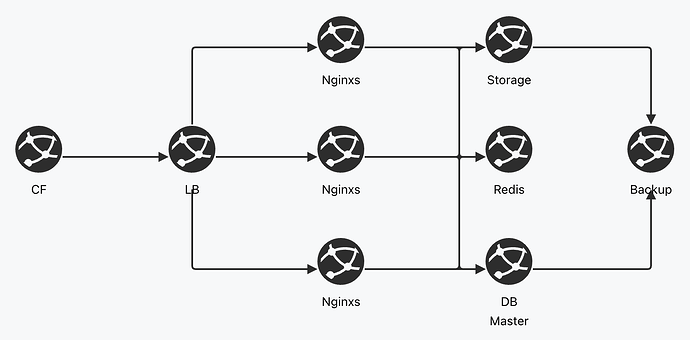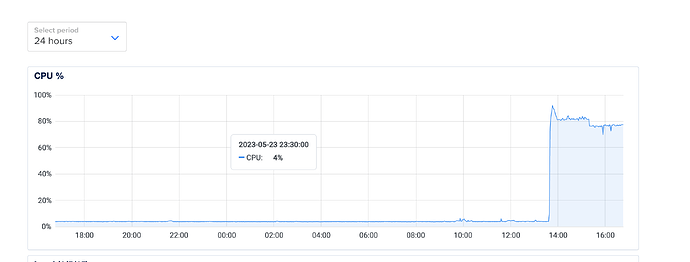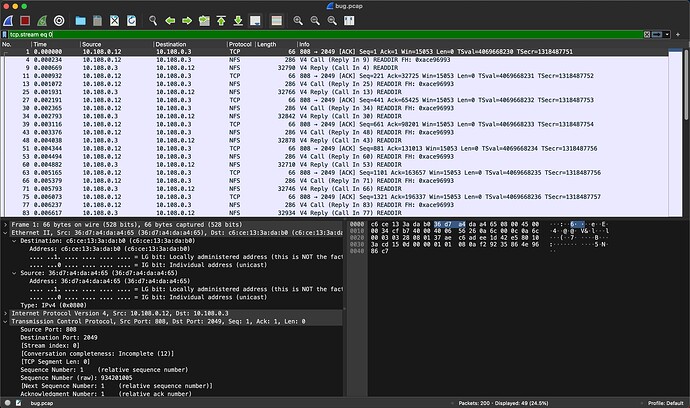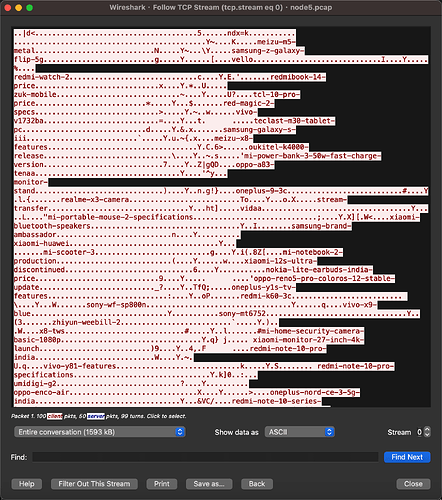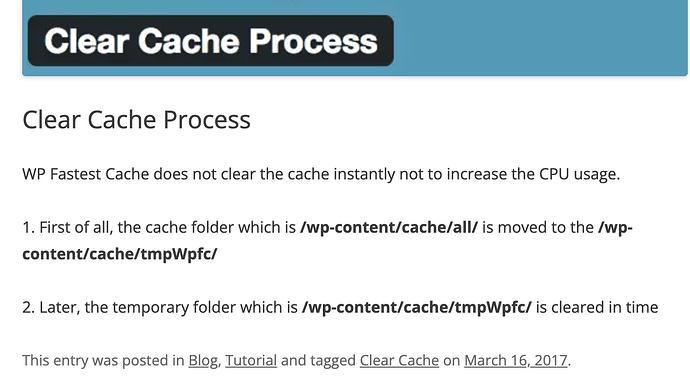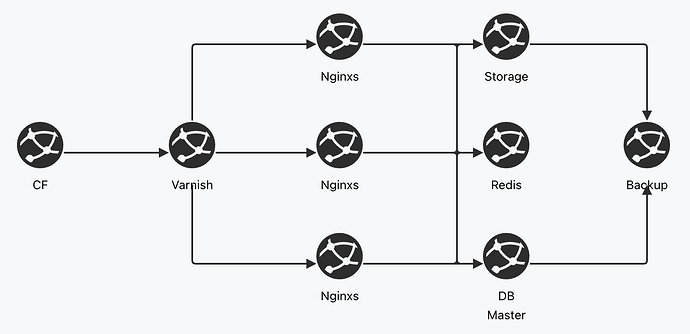背景
手里的一个Wordpress站点最近经常(每个月都有几次)莫名其妙down掉,已经尝试很多次没法解决。
由于每次也都会自动恢复,也就一直没有找到这种故障的真实原因,所以我称之为幽灵故障
今天终于解决了,所以顺手对整个过程做个记录
故障表象
- CPU打满
- 流量异常
- NFSD进程异常
- 磁盘IO正常
架构
先说下这个Wordpress的架构
围绕整个东西向链路详细解释一下:
- 整个服务器集群最前端是Cloudflare, Cloudflare这里主要作为 CDN&filter&SSL 使用
- LB是云自身的,是4层的. 主要功能是用来观测节点情况和自动伸缩负载均衡用
- Nginx最开始有4台,后续因为故障的发生,最高伸缩至了12台,依然没有解决问题,后来降至6台
- Nginx作为计算节点,自带运行有php,可向LB直接返回数据
- 自建的storage存储节点,通过nfs进行业务文件共享
- Redis作为Wordpress的对象存储数据库,Wordpress使用插件对热门数据对象进行缓存,降低数据库压力
- DB有两台,主从结构,主要是主操作,从作为read only进行负载分摊和热数据备份节点
排查
表象
从服务器指标上来看, 最异常的主要就是 CPU/流量 。
- 存储节点
- CPUs占用率80%以上,
- 带宽占用1GB+, 大部分是VPC内的局域网流量。
- 并且大部分流量的source就是这台存储服务器
- 计算节点
- 故障初期CPUs 100%占满,导致业务不可用
- 流量异常,主要是接收的数据来自存储节点
排查CPU
CPU的异常通过top查询,主要是来自nfsd的进程, 该进程是集群网络文件共享的核心。每个进程占vCPU大概50-60%。
整个Wordpress的文件都通过nfsd在集群计算节点之前共享。但是排查了nfsd几个小时,依然没有发现问题。
日志正常,就是CPU高得离谱。通过lsof查询进程,也是一无所获,根本没查到预想的文件死锁之类的情况。
root@storage:~# lsof -p 2222
COMMAND PID USER FD TYPE DEVICE SIZE/OFF NODE NAME
nfsd 2222 root cwd DIR 252,1 4096 2 /
nfsd 2222 root rtd DIR 252,1 4096 2 /
nfsd 2222 root txt unknown /proc/2222/exe
然后通过开关计算计算, 想通过logs或者特征的方式,找出cpu异常的愿意, 依然是没有结果
排查流量异常
通过iftop等分析,总结出主要是存储节点在给计算节点发包导致的。所以流量最大的就是存储节点,因为需要向多个计算节点发包。
所以随即通过tcpdump对存储节点进行抓包,并使用Wireshark进行网络数据包分析.
但是由于存储节点每秒上GB的数据进行传输, 抓出来的包杂乱无章。只是知道充斥来很多NFS的数据包,但是并不知道具体发生了什么事情。
我甚至认为真的是NFS出现了漏洞,导致了这种类似于反射放大的DDOS。
但是如果是DDOS,只攻击内网的服务器,也不符合逻辑和我的预期。
以前发生这种幽灵故障的时候, 基本都是止步于这个阶段。
计算节点流量排查
这次我对结算节点进行了单独的抓包
由于少了很多其他数据包的干扰,更清楚的看到了包的内容和传输过程。
之前只是知道请求了很多READDIR的TCP请求,这次大概知道了为什么。
海量READDIR的请求,然后返回一个数据包。造成了类似反射放大DDOS的效果。
由于Wireshark UI上看到的包都不大, 但是由于TCP分片的效果。通过tcp follow分析,导致实际每个请求都是反射放大了N倍的。
那问题来了, 到底是不是攻击?如果不是攻击那到底是什么原因?
然后我复制数据包中反问的内容,在存储Wordpress文件夹中模糊搜索相关字符串。发现文件处于这个目录下:
/wp-content/cache/tmpWpfc/
然后发现这个内容是由Wordpress的 WP fastest cache 插件造成的,我是买的正版插件啊,怎么还有这种bug??先不管,继续排查。。为什么NFS一个READDIR请求,就导致网络炸掉的原因也找到了。
因为在 /wp-content/cache/tmpWpfc/xxx/tag 目录下,有4.5万个文件夹
通过 ls -l | wc -l 发现在/wp-content/cache/tmpWpfc/xxx/tag 目录下有 4.5万 个文件夹。
也就是说, 计算节点一个READDIR请求, 会有4.5万个文件夹的名字内容从存储节点返回给计算节点。
这也是为啥看起来像是反射DDOS攻击的原因了,确实就是,不过这个是来自于信任的TCP协议。
WHY
那为什么这个 WP fastest cache 插件会有这个问题呢?
通过查阅官方文档终于有了答案:
原文: Clear Cache Process
也就是说, 这个插件不会对过期cache进行定时完整的物理删除。 而且通过目录移动的方式,进行每次的小批量删除。
小批量删除的时候, 就会读取目录树,进行遍历式的删除。由于我使用了网络存储,导致整个网络流量发生了几何形事的倍增,最终导致故障发生。我甚至怀疑由于是集群环境,甚至出现了文件死锁的问题。
如何解决
既然找到了是插件的原因, 那么摆在我面前的就是如何解决这个问题。我心中有两个方案:
- 找个该静态页面生成缓存插件的替代品, 但是测试成本高
- 不使用该类型插件, 肯定会增加服务器负载。
- 找到更好的方式解决FPC(full page cache)的问题。
如何解决
我最终选择了使用更改整个服务器集群架构的方式,解决该问题。
我在整个集群架构中增加一层中间件,专门用作FPC。最终架构如下:
使用varnish替代LB的位置有以下几个好处
- 方便切换,只需要更改CF的解析。立即就可以从老的架构上更换到新的架构上
- 方便测试,只需要新开三台服务器,就可以做线上测试。不需要原始环境停机解决
- 快速恢复, 如果架构更换期间出现问题,可以做快速恢复
- 速度更快,由于varnish相当于是在webserver直接做了memory cache,相对于插件这种形式,还需要进入php的逻辑,理论上速度已经快了百倍
- 抗压能力更好,由于网站访问量巨大。 varnish的response复用形式,可以更好的解决服务器并发压力的问题
- 成本更低,使用varnish后可以降低服务器使用量,撤销LB,更低的成本做更多的事,而且架构更简单
- 可观测性,由于varnish提供了丰富的接口,可对cache的实际情况做更多的观测。
遇到的坑
上面说了这么多好处, 实际配置中还是遇到了比较多的坑。
首先我一直是varnish的忠实用户,有一定的使用经验,所以才让整个架构迁移过程比较平稳快速。
但是我是第一次给Wordpress配置varnish, 而且还是集群环境下。
这里给出我的vcl文件配置,希望能帮助大家。我的配置也可能不适合你的环境,环境你在下面留言。
vcl 4.1;
import std;
import directors;
backend node {
.host = "10.108.0.13";
.port = "80";
}
backend node1 {
.host = "10.108.0.14";
.port = "80";
}
backend node2 {
.host = "10.108.0.12";
.port = "80";
}
# Add hostnames, IP addresses and subnets that are allowed to purge content
acl purge {
"10.108.0.0/24";
"localhost";
"127.0.0.1";
"::1";
}
sub vcl_init {
new vdir = directors.round_robin();
vdir.add_backend(node);
vdir.add_backend(node1);
vdir.add_backend(node2);
}
sub vcl_recv {
# Remove empty query string parameters
# e.g.: www.example.com/index.html?
if (req.url ~ "\?$") {
set req.url = regsub(req.url, "\?$", "");
}
# Remove port number from host header
set req.http.Host = regsub(req.http.Host, ":[0-9]+", "");
# Sorts query string parameters alphabetically for cache normalization purposes
set req.url = std.querysort(req.url);
# Remove the proxy header to mitigate the httpoxy vulnerability
# See https://httpoxy.org/
unset req.http.proxy;
# Add X-Forwarded-Proto header when using https
if (!req.http.X-Forwarded-Proto) {
set req.http.X-Forwarded-Proto = "https";
}
# add UA Diff
if (req.http.User-Agent ~ "Mobile") {
set req.http.X-Varnish-Device = "mobile";
} else {
set req.http.X-Varnish-Device = "desktop";
}
# Set the client IP based on X-Forwarded-For header
if (req.http.X-Forwarded-For) {
set req.http.X-Forwarded-For = regsub(req.http.X-Forwarded-For, ",.*$", "");
set req.http.X-Real-IP = regsub(req.http.X-Forwarded-For, ".*,\s*", "");
remove req.http.X-Forwarded-For;
set req.http.X-Forwarded-For = req.http.X-Real-IP;
}
# Purge logic to remove objects from the cache.
# Tailored to the Proxy Cache Purge WordPress plugin
# See https://wordpress.org/plugins/varnish-http-purge/
if(req.method == "PURGE") {
if(!client.ip ~ purge) {
return(synth(405,"PURGE not allowed for this IP address"));
}
if (req.http.X-Purge-Method == "regex") {
ban("obj.http.x-url ~ " + req.url + " && obj.http.x-host == " + req.http.host);
return(synth(200, "Purged"));
}
ban("obj.http.x-url == " + req.url + " && obj.http.x-host == " + req.http.host);
return(synth(200, "Purged"));
}
# Only handle relevant HTTP request methods
if (
req.method != "GET" &&
req.method != "HEAD" &&
req.method != "PUT" &&
req.method != "POST" &&
req.method != "PATCH" &&
req.method != "TRACE" &&
req.method != "OPTIONS" &&
req.method != "DELETE"
) {
return (pipe);
}
# Remove tracking query string parameters used by analytics tools
if (req.url ~ "(\?|&)(utm_source|utm_medium|utm_campaign|utm_content|gclid|cx|ie|cof|siteurl)=") {
set req.url = regsuball(req.url, "&(utm_source|utm_medium|utm_campaign|utm_content|gclid|cx|ie|cof|siteurl)=([A-z0-9_\-\.%25]+)", "");
set req.url = regsuball(req.url, "\?(utm_source|utm_medium|utm_campaign|utm_content|gclid|cx|ie|cof|siteurl)=([A-z0-9_\-\.%25]+)", "?");
set req.url = regsub(req.url, "\?&", "?");
set req.url = regsub(req.url, "\?$", "");
}
# Only cache GET and HEAD requests
if (req.method != "GET" && req.method != "HEAD") {
set req.http.X-Cacheable = "NO:REQUEST-METHOD";
return(pass);
}
# Mark static files with the X-Static-File header, and remove any cookies
# X-Static-File is also used in vcl_backend_response to identify static files
if (req.url ~ "^[^?]*\.(7z|avi|bmp|bz2|css|csv|doc|docx|eot|flac|flv|gif|gz|ico|jpeg|jpg|js|less|mka|mkv|mov|mp3|mp4|mpeg|mpg|odt|ogg|ogm|opus|otf|pdf|png|ppt|pptx|rar|rtf|svg|svgz|swf|tar|tbz|tgz|ttf|txt|txz|wav|webm|webp|woff|woff2|xls|xlsx|xml|xz|zip)(\?.*)?$") {
set req.http.X-Static-File = "true";
unset req.http.Cookie;
return(hash);
}
# No caching of special URLs, logged in users and some plugins
if (
req.http.Cookie ~ "wordpress_(?!test_)[a-zA-Z0-9_]+|wp-postpass|comment_author_[a-zA-Z0-9_]+|woocommerce_cart_hash|woocommerce_items_in_cart|wp_woocommerce_session_[a-zA-Z0-9]+|wordpress_logged_in_|comment_author|PHPSESSID" ||
req.http.Authorization ||
req.url ~ "add_to_cart" ||
req.url ~ "edd_action" ||
req.url ~ "nocache" ||
req.url ~ "^/addons" ||
req.url ~ "^/bb-admin" ||
req.url ~ "^/bb-login.php" ||
req.url ~ "^/bb-reset-password.php" ||
req.url ~ "^/cart" ||
req.url ~ "^/checkout" ||
req.url ~ "^/control.php" ||
req.url ~ "^/login" ||
req.url ~ "^/logout" ||
req.url ~ "^/lost-password" ||
req.url ~ "^/my-account" ||
req.url ~ "^/product" ||
req.url ~ "^/register" ||
req.url ~ "^/register.php" ||
req.url ~ "^/server-status" ||
req.url ~ "^/signin" ||
req.url ~ "^/signup" ||
req.url ~ "^/stats" ||
req.url ~ "^/wc-api" ||
req.url ~ "^/wp-admin" ||
req.url ~ "^/wp-comments-post.php" ||
req.url ~ "^/wp-cron.php" ||
req.url ~ "^/wp-login.php" ||
req.url ~ "^/wp-activate.php" ||
req.url ~ "^/wp-mail.php" ||
req.url ~ "^/wp-login.php" ||
req.url ~ "^\?add-to-cart=" ||
req.url ~ "^\?wc-api=" ||
req.url ~ "^/preview=" ||
req.url ~ "^/\.well-known/acme-challenge/"
) {
set req.http.X-Cacheable = "NO:Logged in/Got Sessions";
if(req.http.X-Requested-With == "XMLHttpRequest") {
set req.http.X-Cacheable = "NO:Ajax";
}
return(pass);
}
# Remove any cookies left
unset req.http.Cookie;
return(hash);
set req.backend_hint = vdir.backend();
}
sub vcl_hash {
if(req.http.X-Varnish-Device) {
# Create cache variations depending on the request protocol
hash_data(req.http.X-Varnish-Device);
}
}
sub vcl_backend_response {
# Inject URL & Host header into the object for asynchronous banning purposes
set beresp.http.x-url = bereq.url;
set beresp.http.x-host = bereq.http.host;
# If we dont get a Cache-Control header from the backend
# we default to 1h cache for all objects
if (!beresp.http.Cache-Control) {
set beresp.ttl = 1h;
set beresp.http.X-Cacheable = "YES:Forced";
}
# If the file is marked as static we cache it for 1 day
if (bereq.http.X-Static-File == "true") {
unset beresp.http.Set-Cookie;
set beresp.http.X-Cacheable = "YES:Forced";
set beresp.ttl = 1d;
}
# Remove the Set-Cookie header when a specific Wordfence cookie is set
if (beresp.http.Set-Cookie ~ "wfvt_|wordfence_verifiedHuman") {
unset beresp.http.Set-Cookie;
}
if (beresp.http.Set-Cookie) {
set beresp.http.X-Cacheable = "NO:Got Cookies";
} elseif(beresp.http.Cache-Control ~ "private") {
set beresp.http.X-Cacheable = "NO:Cache-Control=private";
}
}
sub vcl_deliver {
# Debug header
if(req.http.X-Cacheable) {
set resp.http.X-Cacheable = req.http.X-Cacheable;
} elseif(obj.uncacheable) {
if(!resp.http.X-Cacheable) {
set resp.http.X-Cacheable = "NO:UNCACHEABLE";
}
} elseif(!resp.http.X-Cacheable) {
set resp.http.X-Cacheable = "YES";
}
# Cleanup of headers
unset resp.http.x-url;
unset resp.http.x-host;
}
注意,该配置文件是适配于我集群环境下的配置文件。如果你想复用, 请根据自己的环境修改。
总结
- NFS性能低
- wp fattest插件有大坑
- 插件文件夹遍历的问题+NFS网络传输,最终导致了类似于反射放大DDOS的效果。
- 集群分散的架构方便后续维护升级时的处理和故障感知。
- varnish大法好
- wp代码和架构真心烂
- 最初的架构设计也有问题,程序代码不应该放在NFS,应该和静态资源做分离。但是工作量大,也没去做
